Getting Ripped at the Beach Can Ruin Your Spring Break
Special Stories
6 Mar 2018 6:44 PM
Spring break from school for many students means a trip to the beach. Of course there are many hazards one might encounter on spring break but right now let’s focus on rip currents.
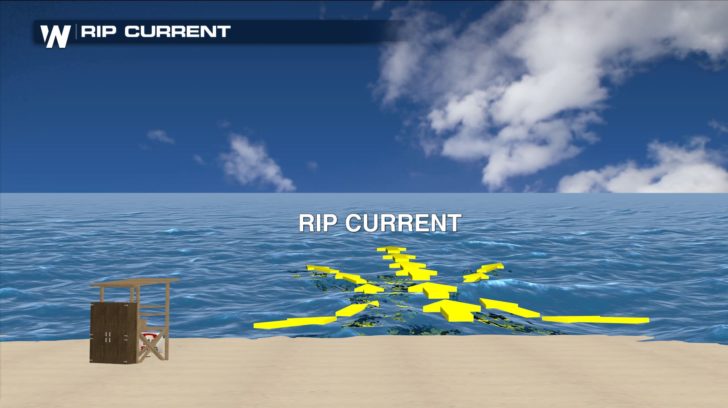 Rip currents are the number one surf hazard for swimmers at the beach.
More than 100 drownings occur every year due to rip currents in the United States.
Rip currents are the number one surf hazard for swimmers at the beach.
More than 100 drownings occur every year due to rip currents in the United States.
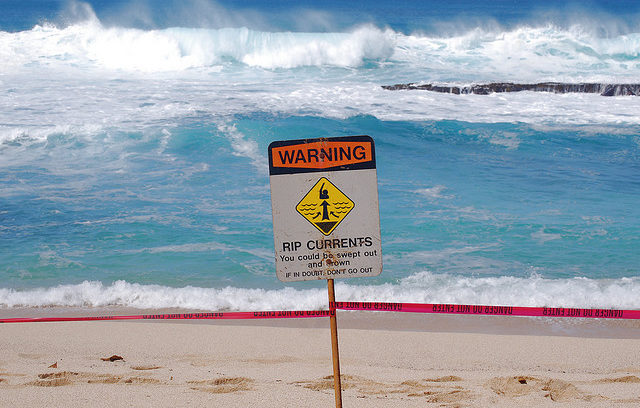 Rip currents are a relatively strong, narrow current of water flowing outward from the beach through the surf zone which can present a hazard to swimmers. Even the strongest swimmers can be quickly pulled out a great distance from the shore in a rip current much too fast to swim against.
Rip currents are a relatively strong, narrow current of water flowing outward from the beach through the surf zone which can present a hazard to swimmers. Even the strongest swimmers can be quickly pulled out a great distance from the shore in a rip current much too fast to swim against.
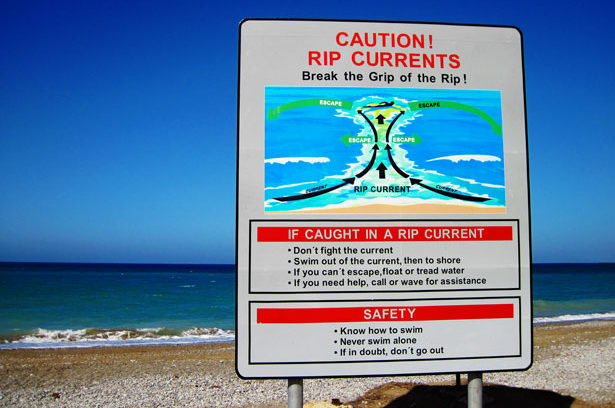 Rip currents form as waves push water onshore. The water builds up and often excess water will travel along the shoreline until it reaches a path of least resistance and flows quickly back into the ocean as a rip current with great force.
Most rip current are narrow and set up between sandbars, under piers and along jetties. Rip currents can also be mobile traveling along the beach in the right conditions.
Knowing just where a rip current is a matter of identifying it which can be a bit tricky. When looking for rip currents a pair of polarized sunglasses can help.
Rip currents form as waves push water onshore. The water builds up and often excess water will travel along the shoreline until it reaches a path of least resistance and flows quickly back into the ocean as a rip current with great force.
Most rip current are narrow and set up between sandbars, under piers and along jetties. Rip currents can also be mobile traveling along the beach in the right conditions.
Knowing just where a rip current is a matter of identifying it which can be a bit tricky. When looking for rip currents a pair of polarized sunglasses can help.
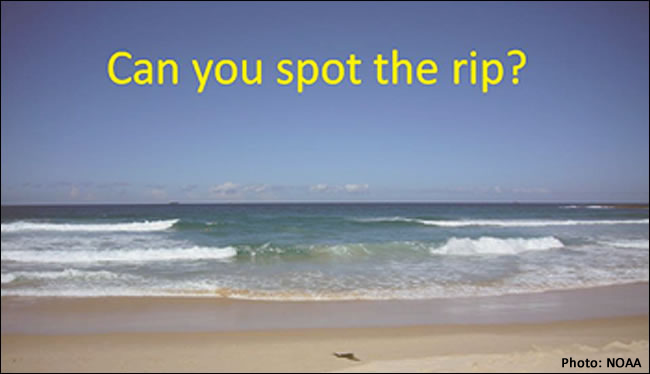 Important indications of a rip current can include:
A channel of churning, choppy water
An area having a notable difference in water color
A line of foam, seaweed, or debris moving steadily seaward
A break in the incoming wave pattern
These clues can help identify rip currents but even without these indications being apparent, a rip current could be occurring.
Rip currents can be deadly, carrying people far out from the beach but there are a few proper steps and ideas that can keep you and others out of rip current danger.
Important indications of a rip current can include:
A channel of churning, choppy water
An area having a notable difference in water color
A line of foam, seaweed, or debris moving steadily seaward
A break in the incoming wave pattern
These clues can help identify rip currents but even without these indications being apparent, a rip current could be occurring.
Rip currents can be deadly, carrying people far out from the beach but there are a few proper steps and ideas that can keep you and others out of rip current danger.
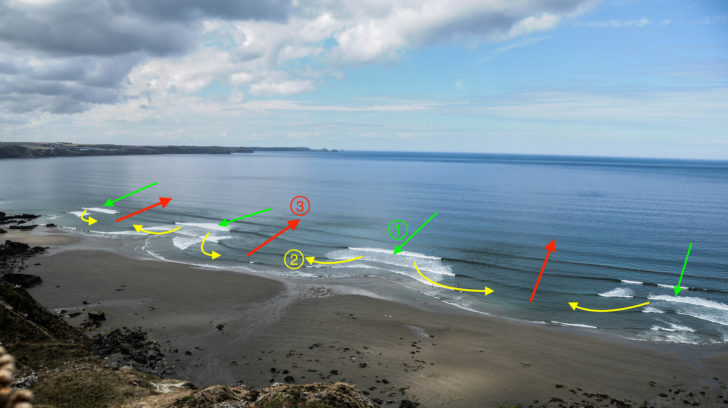 First of all learn how to swim before you need this skill at the beach. Understand that swimming in a pool is much different than swimming in the surf zone at the beach.
Never swim alone.
Be alert to dangers at all times. If in doubt, don't go out!
It's best if possible to swim at a lifeguard protected beach.
Follow instructions from lifeguards. They are working to keep everyone safe.
If caught in a rip current, remain calm to conserve energy and think clearly.
Don't fight the current. Swim out of the current in a direction following the shoreline.
When out of the current, swim towards shore.
If you are unable to swim out of the rip current, float or calmly tread water.
When out of the current, swim towards shore.
If you are still unable to reach shore, draw attention to yourself: face the shore, wave your arms, and yell for help.
If you see someone in trouble, get help from a lifeguard. If a lifeguard is not available, have someone call 9-1-1 . Throw the rip current victim something that floats and yell instructions on how to escape. Remember, many people drown while trying to save someone else from a rip current.
First of all learn how to swim before you need this skill at the beach. Understand that swimming in a pool is much different than swimming in the surf zone at the beach.
Never swim alone.
Be alert to dangers at all times. If in doubt, don't go out!
It's best if possible to swim at a lifeguard protected beach.
Follow instructions from lifeguards. They are working to keep everyone safe.
If caught in a rip current, remain calm to conserve energy and think clearly.
Don't fight the current. Swim out of the current in a direction following the shoreline.
When out of the current, swim towards shore.
If you are unable to swim out of the rip current, float or calmly tread water.
When out of the current, swim towards shore.
If you are still unable to reach shore, draw attention to yourself: face the shore, wave your arms, and yell for help.
If you see someone in trouble, get help from a lifeguard. If a lifeguard is not available, have someone call 9-1-1 . Throw the rip current victim something that floats and yell instructions on how to escape. Remember, many people drown while trying to save someone else from a rip current.
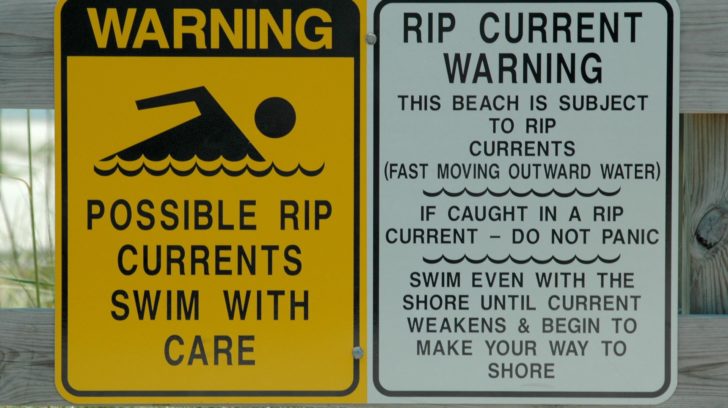
 Rip currents are the number one surf hazard for swimmers at the beach.
More than 100 drownings occur every year due to rip currents in the United States.
Rip currents are the number one surf hazard for swimmers at the beach.
More than 100 drownings occur every year due to rip currents in the United States.
 Rip currents are a relatively strong, narrow current of water flowing outward from the beach through the surf zone which can present a hazard to swimmers. Even the strongest swimmers can be quickly pulled out a great distance from the shore in a rip current much too fast to swim against.
Rip currents are a relatively strong, narrow current of water flowing outward from the beach through the surf zone which can present a hazard to swimmers. Even the strongest swimmers can be quickly pulled out a great distance from the shore in a rip current much too fast to swim against.
 Rip currents form as waves push water onshore. The water builds up and often excess water will travel along the shoreline until it reaches a path of least resistance and flows quickly back into the ocean as a rip current with great force.
Most rip current are narrow and set up between sandbars, under piers and along jetties. Rip currents can also be mobile traveling along the beach in the right conditions.
Knowing just where a rip current is a matter of identifying it which can be a bit tricky. When looking for rip currents a pair of polarized sunglasses can help.
Rip currents form as waves push water onshore. The water builds up and often excess water will travel along the shoreline until it reaches a path of least resistance and flows quickly back into the ocean as a rip current with great force.
Most rip current are narrow and set up between sandbars, under piers and along jetties. Rip currents can also be mobile traveling along the beach in the right conditions.
Knowing just where a rip current is a matter of identifying it which can be a bit tricky. When looking for rip currents a pair of polarized sunglasses can help.
 Important indications of a rip current can include:
A channel of churning, choppy water
An area having a notable difference in water color
A line of foam, seaweed, or debris moving steadily seaward
A break in the incoming wave pattern
These clues can help identify rip currents but even without these indications being apparent, a rip current could be occurring.
Rip currents can be deadly, carrying people far out from the beach but there are a few proper steps and ideas that can keep you and others out of rip current danger.
Important indications of a rip current can include:
A channel of churning, choppy water
An area having a notable difference in water color
A line of foam, seaweed, or debris moving steadily seaward
A break in the incoming wave pattern
These clues can help identify rip currents but even without these indications being apparent, a rip current could be occurring.
Rip currents can be deadly, carrying people far out from the beach but there are a few proper steps and ideas that can keep you and others out of rip current danger.
 First of all learn how to swim before you need this skill at the beach. Understand that swimming in a pool is much different than swimming in the surf zone at the beach.
Never swim alone.
Be alert to dangers at all times. If in doubt, don't go out!
It's best if possible to swim at a lifeguard protected beach.
Follow instructions from lifeguards. They are working to keep everyone safe.
If caught in a rip current, remain calm to conserve energy and think clearly.
Don't fight the current. Swim out of the current in a direction following the shoreline.
When out of the current, swim towards shore.
If you are unable to swim out of the rip current, float or calmly tread water.
When out of the current, swim towards shore.
If you are still unable to reach shore, draw attention to yourself: face the shore, wave your arms, and yell for help.
If you see someone in trouble, get help from a lifeguard. If a lifeguard is not available, have someone call 9-1-1 . Throw the rip current victim something that floats and yell instructions on how to escape. Remember, many people drown while trying to save someone else from a rip current.
First of all learn how to swim before you need this skill at the beach. Understand that swimming in a pool is much different than swimming in the surf zone at the beach.
Never swim alone.
Be alert to dangers at all times. If in doubt, don't go out!
It's best if possible to swim at a lifeguard protected beach.
Follow instructions from lifeguards. They are working to keep everyone safe.
If caught in a rip current, remain calm to conserve energy and think clearly.
Don't fight the current. Swim out of the current in a direction following the shoreline.
When out of the current, swim towards shore.
If you are unable to swim out of the rip current, float or calmly tread water.
When out of the current, swim towards shore.
If you are still unable to reach shore, draw attention to yourself: face the shore, wave your arms, and yell for help.
If you see someone in trouble, get help from a lifeguard. If a lifeguard is not available, have someone call 9-1-1 . Throw the rip current victim something that floats and yell instructions on how to escape. Remember, many people drown while trying to save someone else from a rip current.

How to Avoid Getting Caught in a Rip Current
- Learn more about rip currents and beach safety developed by Texas A&M
- Check water conditions before going in by looking at the local beach forecast before you leave for the beach and talking to the lifeguard at the beach.
- Only swim at a beach with lifeguards. The chances of drowning at a beach with lifeguards are 1 in 18 million (U.S. Lifesaving Association).
- Don't assume! Great weather for the beach does not always mean it's safe to swim or even play in the shallows. Rip currents often form on calm, sunny days.
- Learn how to spot a rip current. The Break the Grip of the Rip free online training will help you learn how to spot a rip current.
- What are scientists doing to keep swimmers safer? Find out in this video: Predict the Rip
- Rip currents aren't the only deadly beach hazard. Learn more about dangerous waves and other hazards and why you should never to turn your back on the ocean.
All Weather News
More